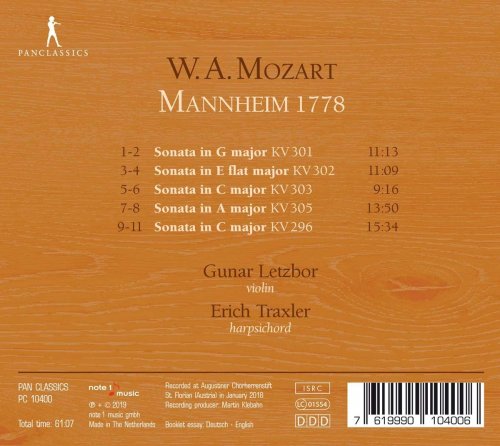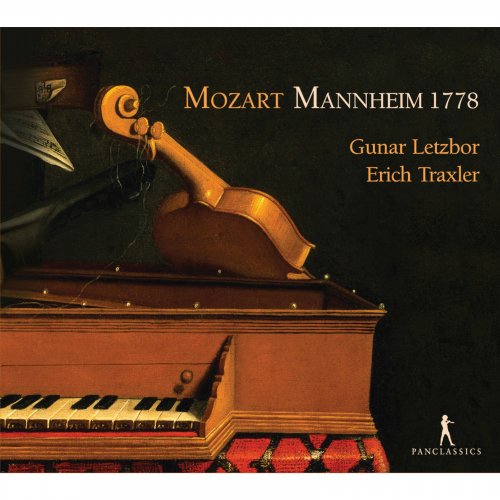
Gunar Letzbor, Erich Traxler - Mozart: Mannheim 1778 (2019)
BAND/ARTIST: Gunar Letzbor, Erich Traxler
- Title: Mozart: Mannheim 1778
- Year Of Release: 2019
- Label: Pan Classics
- Genre: Classical
- Quality: flac lossless (tracks) +Booklet
- Total Time: 01:01:04
- Total Size: 347 mb
- WebSite: Album Preview
Tracklist
01. Violin Sonata in G Major, K. 301: I. Allegro con spirito
02. Violin Sonata in G Major, K. 301: II. Allegro
03. Violin Sonata in E-Flat Major, K. 302: I. Allegro
04. Violin Sonata in E-Flat Major, K. 302: II. Rondeau. Andante grazioso
05. Violin Sonata in C Major, K. 303: I. Adagio - Allegro molto - Adagio - II. Allegro molto
06. Violin Sonata in C Major, K. 303: III. Tempo di minuetto
07. Violin Sonata in A Major, K. 305: I. Allegro di molto - Andante grazioso con variazioni
08. Violin Sonata in A Major, K. 305: II. Temo con variazioni. Andante grazioso - Vars. 1-4
09. Violin Sonata in C Major, K. 296: I. Allegro vivace
10. Violin Sonata in C Major, K. 296: II. Andante sostenuto
11. Violin Sonata in C Major, K. 296: III. Rondeau. Allegro

The violin sonata in Mozart's time evolved less from the Baroque sonata for violin and continuo than from the keyboard sonata with optional violin accompaniment, and Mozart's early efforts in the genre reflect that origin. From the beginning, Mozart was feeling his way toward the balance that would eventually result in the violin-and-piano sonata of Beethoven's time, but there is something of the transitional about these sonatas. The violin part sometimes gets melodic material, most often restating what the keyboard has already said, but it also has long passages of plain harmony notes. The unusual feature about the set of Mozart sonatas, written in Mannheim, Germany, in 1778, is that a harpsichord is used in the keyboard part. This may be of interest to historical-performance fans interested in Mozart, and the harpsichord, by Keith Hill after the Dutch builder Ruckers, is a splendidly clear and sparkling instrument. It also doesn't have a prayer of standing up to the violin of Gunar Letzbor, and the overall effect is one of hearing a lot of stabbing notes on the violin underlaid by quiet runs on the harpsichord. Letzbor argues that in 1778 the harpsichord would have been the most common keyboard instrument in Germany, and this is true. However, Mozart was keenly interested in the fortepiano, and in a progressive genre like this one, in the process of being formed, the fortepiano seems necessary. Some of the pieces work better on the harpsichord than others; you could sample the first movement of the Violin Sonata in C major, K. 303, with its brilliant conclusion, to hear the combination at its best. The sound engineering is partly to blame for the imbalance between the two instruments. The monastery setting hardly resembles a space in which these sonatas would have been played, and it helps to bury the harpsichord behind the violin's chirps.
01. Violin Sonata in G Major, K. 301: I. Allegro con spirito
02. Violin Sonata in G Major, K. 301: II. Allegro
03. Violin Sonata in E-Flat Major, K. 302: I. Allegro
04. Violin Sonata in E-Flat Major, K. 302: II. Rondeau. Andante grazioso
05. Violin Sonata in C Major, K. 303: I. Adagio - Allegro molto - Adagio - II. Allegro molto
06. Violin Sonata in C Major, K. 303: III. Tempo di minuetto
07. Violin Sonata in A Major, K. 305: I. Allegro di molto - Andante grazioso con variazioni
08. Violin Sonata in A Major, K. 305: II. Temo con variazioni. Andante grazioso - Vars. 1-4
09. Violin Sonata in C Major, K. 296: I. Allegro vivace
10. Violin Sonata in C Major, K. 296: II. Andante sostenuto
11. Violin Sonata in C Major, K. 296: III. Rondeau. Allegro

The violin sonata in Mozart's time evolved less from the Baroque sonata for violin and continuo than from the keyboard sonata with optional violin accompaniment, and Mozart's early efforts in the genre reflect that origin. From the beginning, Mozart was feeling his way toward the balance that would eventually result in the violin-and-piano sonata of Beethoven's time, but there is something of the transitional about these sonatas. The violin part sometimes gets melodic material, most often restating what the keyboard has already said, but it also has long passages of plain harmony notes. The unusual feature about the set of Mozart sonatas, written in Mannheim, Germany, in 1778, is that a harpsichord is used in the keyboard part. This may be of interest to historical-performance fans interested in Mozart, and the harpsichord, by Keith Hill after the Dutch builder Ruckers, is a splendidly clear and sparkling instrument. It also doesn't have a prayer of standing up to the violin of Gunar Letzbor, and the overall effect is one of hearing a lot of stabbing notes on the violin underlaid by quiet runs on the harpsichord. Letzbor argues that in 1778 the harpsichord would have been the most common keyboard instrument in Germany, and this is true. However, Mozart was keenly interested in the fortepiano, and in a progressive genre like this one, in the process of being formed, the fortepiano seems necessary. Some of the pieces work better on the harpsichord than others; you could sample the first movement of the Violin Sonata in C major, K. 303, with its brilliant conclusion, to hear the combination at its best. The sound engineering is partly to blame for the imbalance between the two instruments. The monastery setting hardly resembles a space in which these sonatas would have been played, and it helps to bury the harpsichord behind the violin's chirps.
Year 2019 | Classical | FLAC / APE
As a ISRA.CLOUD's PREMIUM member you will have the following benefits:
- Unlimited high speed downloads
- Download directly without waiting time
- Unlimited parallel downloads
- Support for download accelerators
- No advertising
- Resume broken downloads


